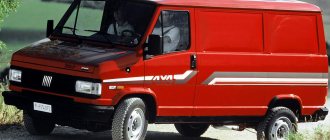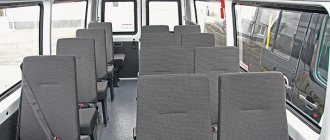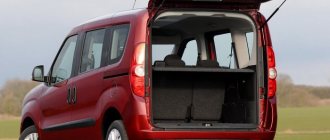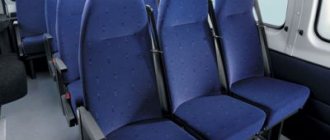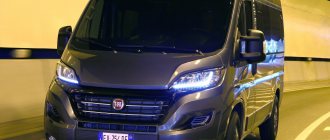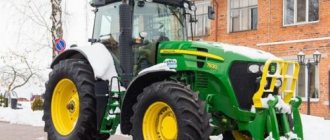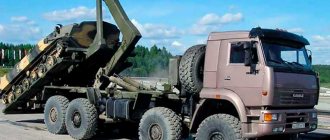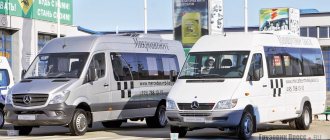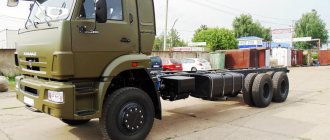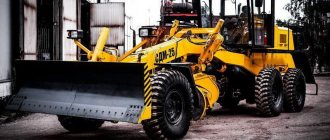The Italian minibus Fiat Ducato has been produced since 1981. The first generation of cars, whose load capacity reached 1.8 tons, was equipped with six different units. The top engine was considered a 2.5-liter turbodiesel with 94 horsepower.
In 1994, the updated generation of Ducato entered the market. After 4 years, the line of power units is replenished with the notorious 2.8-liter diesel engine from Iveco. In 2003, the manufacturer carried out a restyling and increased the load capacity of the minibus to 3–3.5 tons. Since 2006, the third generation Ducato has been produced with Multijet series engines with power from 99 to 180 horsepower. In Russia, the model has been officially sold since 2012. In 2014, it underwent restyling.
It is noteworthy that atmospheric engines of the first two generations run 500–800 thousand km . But turbocharged versions, especially Multijet series engines, are sensitive to the quality of domestic diesel fuel. Although the manufacturer claims a service life of about one million kilometers for the engines of new Ducato minibuses produced after 2014. Taking into account service intervals of 20 thousand km for Russia and 48 thousand km for Europe, and also taking into account the overload of commercial vehicles, this is unlikely to be possible. It is worth paying tribute to the three-liter units with a capacity of 180 horsepower, which have already proven themselves to be excellent.
Typical symptoms of a Ducato internal combustion engine breakdown include a drop in power, excessive vibrations, and fluctuations in idle speed. During diagnostics and troubleshooting, additional defects are revealed: wear of the studs, damage to the cylinder block and timing chain. Because of all this, repairs become more expensive.
It is noteworthy that in the Fiat model range, in addition to the Ducato, there is also a more compact minibus - the Scudo. It has been produced since 1995 and is equipped with engines ranging from 1.6 to 2.0 liters. The updated model is equipped with Multijet series power units. They are equipped with injectors with an electronic control system, which are extremely sensitive to fuel quality. The situation is aggravated by an increase in service intervals when using Long Life lubricants. When the number on the odometer exceeds 100 thousand km, the consumption of oil, which goes to waste, increases. A characteristic black smoke appears from the exhaust pipe.
[ads1]
To extend the life of a Fiat Ducato or Scudo diesel power unit, we recommend using the RVS-Master friction geomodifier. It, unlike additives, does not contain chlorine and paraffin, which clog the combustion chamber. The action of the composition is based on the principle of serpentization - Mg atoms replace Fe atoms from the surface layer of the metal.
The newly formed metal-ceramic layer restores the contact parts. Compression increases up to the rated values. Increasing the strength of components extends the life of the internal combustion engine - up to 120 thousand km. RVS treatment transforms the metal surface, but while eliminating wear, the strength and wear resistance of the base materials do not deteriorate. Normalizing the operation of the power unit leads to a reduction in fuel consumption by an average of 5–7%. By reducing the amount of oil that goes to waste, the smokiness decreases.
Detailed review of Fiat Ducato. Characteristics and history of the model.
Categories
Almost 4 decades is a respectable age for any car.
As for the Fiat Ducato, it seems that these commercial vehicles are only gaining momentum. With each generation (the third is now being produced), they are improved, becoming more functional, comfortable and economical. During its production, Ducato sold more than 2 million cars around the world. In addition, it is one of the “triplets” produced at the same SEVEL car plant, where they simultaneously make the Fiat Ducato, the Jumper for Citroen, and the Boxer for Peugeot. The cars have identical platforms, very similar bodies, differing only in engines.
Features of operating Fiat engines - Fiat Ducato
More than one article can be written about the design and features of Fiat car engines, but we will focus our attention on the two most popular models in Russia - the Fiat Ducato commercial minibus/minitruck assembled in Yelabuga (Russia) and the popular Fiat Albea sedan, also assembled in Russia, in the city of Naberezhnye Chelny.
Let's start with the sedan. Albea is equipped with 4 petrol and one diesel engines. Gasoline modifications are injection 1.2i l (with 8 and 16 valves and, respectively, 60 and 80 hp of power), 1.4i l (8 valves 77 hp) and 1.6 i l (16 valves, 103 hp). There is one diesel engine - 1.2 liters, with a power of 70 hp. With. It is difficult to identify any characteristic shortcomings regarding these motors. Breakdowns do happen, but no more often and no less frequently than with cars from other manufacturers. Among the shortcomings, one can highlight only the complaints of drivers about the lack of power, which is especially felt when trying to quickly change lanes in city traffic. This applies most of all to engines with a power of 60 and 70 hp.
As for the Fiat Ducato, it has its advantages and disadvantages. First, about the advantages. The latest generation of diesel engines (with which the Ducato is equipped) have an improved injection system, which has made it possible to reduce fuel consumption by more than 15% without sacrificing power. The minibus is equipped with diesel engines with Common Rail Multijet direct injection:
- 120 Multijet 2.3 l. power 120 l. With.
- 130 Multijet 2.3 l. power 130 hp With.
- 160 Multijet 3.0 l. power 157 hp With.
In combination with a 6-speed gearbox, all engines can create high torque at low speeds, which allows you to operate the car economically in all driving modes - from city traffic jams to high-speed country roads.
As for the shortcomings, we cannot fail to mention the problem faced by the first owners of the 3rd generation Fiat Ducato produced in Elabuga - oil starvation due to freezing of the crankcase ventilation system. The problem area was a cylindrical pipe with a small outlet in the side wall, which sometimes became blocked by ice condensation formed when warm crankcase gas came into contact with cold air. In other cars, similar situations most often lead to knocking out the oil dipstick, but the Elabuga Ducato, due to the design feature of the weaker (but more wear-resistant compared to rubber) fluoroplastic front crankshaft oil seal, the “oil river” found a way out out.
Starting from 2009, this problem was solved by shortening the pipe to the part that protruded into the intake tract, which increased the cross-section of the gas line. Then the system itself was structurally modified. Another Ducato engine problem is the bending timing belt tension roller stops, which can lead to damage to the timing rockers. However, according to official representatives, this is not a problem, but a protective mechanism, where the rockers play the role of a mechanical fuse that absorbs the blow to the valves and pistons when the timing drive is mismatched. This usually happens during a cold start from a tug.
Traditionally, we list the most popular spare parts for the Fiat engine and its cooling system:
- Thermostat.
- Water pump.
- Timing belt and drive belt.
- Valve cover and head gaskets.
- Tension roller.
- Water and air conditioning radiators.
- Compressor.
- Generator.
- Starter.
- Air filter and muffler.
We also traditionally want to remind you that in the Detali812.ru online store you will find a large selection of original spare parts and high-quality duplicates for Fiat Albea, Ducato (including those assembled in Elabuga), 500, Doblo, Palio, Weekend, Punto, Panda, Stilo, Bravo and other models. We guarantee affordable prices and high-quality service with delivery to any region of Russia.
detail812.ru
Fiat Ducato: history of the model
The first Fiat Ducato rolled off the assembly line in 1981. It was a successful collaboration between two Italian auto giants: Fiat and the Peugeot-Citroen (PSA) tandem. The only thing that the first generation can be reproached for is the excess of gasoline engines to complete the model (there were exactly three of them). Consumers liked economical and high-torque diesel engines more, so already from the second generation of Fiat Ducato they became the flagship.
The second generation entered the market in 1993. In addition to significant modernization of the exterior, changes affected the power units. Instead of as many as 6 engines, 3 diesel engines appear, including turbocharged ones, which Fiat prefers in the future (naturally, the diesel engines themselves are being improved, and new ones appear). In 2002, Ducato was restyled, but in general, Fiat Ducato retained its characteristics until 2006, when the third generation of the minibus appeared.
2006 was marked by more than just that. In addition to the gorgeous presentation of the Ducato III, which was held in Madrid, Fiat is launching a licensed assembly of the Ducato in Russia. Despite the seemingly logical decision to assemble third-generation cars, the second was launched in Elabuga, as before in Brazil and Turkey. Nevertheless, “Elabuga” cars become bestsellers, however, mainly because of the competitive price.
Body types of Fiat Ducato
First, a few facts that will be of interest to all fans of these commercial vehicles. You can easily find a Fiat Ducato utility vehicle, purchase a purely passenger version or a cargo version. But few people know that:
Ducato bodies (as well as Jumper and Boxer) have 1263 (!) types of designs and their variants.
Before being sent to dealers, the car is checked at 14 points for compliance with the geometry. And Italian conveyor robots are designed for 3 million welding points and have no restrictions on service life.
Only the Fiat Ducato van (not counting other models) today is available in 13 modifications with a load capacity of 995-1900 kg and a useful volume of 8-17 “cubes”.
Minibus drivers specially purchase Fiat Ducato with a long L4H2 body. This van can be inexpensively converted in a couple of days, stuffed with narrow seats, and sent out on the route.
Like any line of commercial vehicles, Ducato has several body types: a “pure” truck (solid van), flatbed, passenger minibus and something in between (combi with a van or platform). Available in 3 lengths and 2 heights. Distinctive features: low thresholds, functionality and convenience, wide doors, large useful volume.
Front-wheel drive is another plus of the car, it is not only improved cross-country ability and maneuverability. The absence of a cardan on the Ducato made it possible to significantly lower the floor level. And this is convenient for loading and unloading operations, and for minibus passengers. There is a large selection of combined models of the Ducato Combi minibus with a double-row cab and a large cargo compartment (L1H1/L2H2 bodies). In addition, cars with some body styles were more affordable due to domestic production.
Features of Fiat Ducato Elabuga
Minibuses exclusively for the domestic market were assembled in Elabuga in 2006-2011. The Fiat Ducato 244 (and others) for the Russian market was specially adapted taking into account the quality of diesel fuel, operating features and less stringent “environmental” legislation. Plus there was the inevitable lower quality of some components and the assembly line.
Despite the relatively low cost (slightly less than half a million “wooden” ones at the start), by 2011, sales of the imported 3rd generation Ducato and the domestic 2nd were almost equal. And it was decided to curtail production, expanding access to Italian-made machines.
Variety of engines for Fiat Ducato
From the very first generation, Italian minibuses and vans were equipped with Fiat's own power units, which are produced at the SOFIM plant in Foggia. The line of power units also includes English-assembled Puma engines (a joint venture with Ford). The modern 3rd generation Ducato for Russia is equipped exclusively with F1A power units produced by SOFIM (turbodiesel with 120 “horses”, volume 2.3 liters, Euro-4 compliance, Common Rail, etc.).
The engine is specially adapted to domestic realities with disgusting quality of diesel fuel and other troubles. The car, among other things, is equipped with fuel heating, which is extremely important for the Russian climate. And it is no coincidence that 2009 brought Ducato the title of car of the year and best van, largely thanks to the engine.
In total, during its production, Fiat used several power units of various sizes and parameters for its commercial vehicles. Some of them are still in great demand as contract engines.
Generation Fiat Ducato
Car modification
Engine size and type
Years of manufacture
Change of generations of power units
The first Ducato used 3 gasoline and diesel engines. Among gasoline engines (and among others), the smallest was a 4-cylinder unit with a volume of 1.8 liters. And the most popular was the 94-horsepower 2.5-liter turbodiesel. With the change of generations, as we have already said, the Italians abandoned gasoline engines altogether (with one exception), and expanded the line of diesel engines, adding volume and power.
The 1998 Fiat Ducato receives an Iveco power unit under the hood. Almost immediately, the naturally aspirated 2.8-liter engine is replaced by a turbocharged version. In addition, the line of car models was diversified with the appearance of modifications of the Goods Transport, Combi and Passenger Transport bodies, each of which had its own engines.
Thus, Goods Transport became the proud owner of a 99-horsepower gasoline unit and two turbodiesels at once, while the rest received modified JTD diesel engines and a choice of transmission: manual transmission-5 or 4-speed automatic. In 2003, the older 2.5 JTD left the engine line, and the Fiat Ducato 2.3 engine (and others) noticeably increases in power, gradually moving from Euro-4 to the new environmental standard Euro-5.
At the same time, the overall load capacity of the Fiat Ducato is increased. For the Maxi 35 modification it reaches 3.5 tons, and for the Maxi 40, respectively, as much as 4, to which the power units could not help but react. Fiat is finally turning away from gasoline; the list of engines includes only Multijet diesel engines from 2.2 to 3.0 liters with a power of 99-155 “horses”. Only Multijet 2.3 l is supplied to Russia. The advantages of these engines are a unique injection technology patented by Fiat with reduced fuel consumption.
maintenance, operation, breakdowns, repairs, selection and purchase
Quick question
We are always happy to help, ask questions and our specialists will find a solution
1110
The second gear engages with a crunch, sometimes if you play the clutch pedal a little it can engage clearly! The fourth and sixth gear can sometimes crunch
Reply 2Responses
antifreeze was driven out from under the plug of the Fiat Ducato engine block. what to do?
Reply 3Responses
We cannot start the 2012 Ducato 2.3 engine after a rebuild. We bought a timing belt with markings, set it according to the marks and direction, everything was correct. The engine does not start, but only smokes white and bluish smoke. We connected the scanner and the launch showed error 0335. We installed another sensor, same error (the sensor is unknown whether it is intact or not). Lily Quick Start wants to start it but it doesn’t work. Help me what could be the reason. Thank you in advance!
Reply 1Replies
When cold, the filament burns for a long time and then blinks for a long time. It starts up as if on three cylinders. The spark plugs are new. In five seconds. everything is OK. Problem ? Fiat Ducato 2.3
Reply 0 Replies
Tell me, how many liters of oil is needed for the Fiat Ducato gearbox, how often to change it and what kind of oil is needed?
Reply 2Responses
How many liters of diesel fuel does a Fiat Ducato with a 2.3 liter diesel engine consume in reality?
Reply 3Responses
What is the fuel tank capacity of the Fiat Ducato?
Reply 2Responses
A triangle with an exclamation mark lights up on the panel, yellow
Reply 1 Replies What is the ground clearance level of the passenger version of the Fiat Ducato? Reply 1Replies
What engine oil is best to fill in a 2.3 liter Fiat Ducato diesel engine, how much oil is needed? And will it be necessary to top it up?
Reply 1Replies
What kind of rims and tires is the Fiat Ducato minibus equipped with? Tell me their factory dimensions - bolt pattern, offset, width.
Reply 1Replies Sik 4 years ago
Where is the Fiat Ducato, which is sold on the Russian market, assembled?
Reply 2Responses
Did you like the question?
Then click “Like” and add points to the person who asked the question.
All articles
16.08.2018
15.08.2018
13.08.2018
11.08.2018
08.08.2018
06.08.2018
avtoexperts.ru
New Fiat Ducato: characteristics and advantages
The modern Ducato has become the brainchild of Centro Stile Fiat, which has retained the main advantages of the car of previous generations: front-wheel drive, excellent suspension (McPherson strut in front, springs with telescopic shock absorbers in the rear), recognizable exterior, convenience and reliability.
The body is available in three main variations, has excellent streamlining with a record low coefficient of resistance in the class (0.31), and the capacity of the van has increased. The practicality that a commercial vehicle requires is retained. For example, the new bumper has become composite, which reduces the cost of restoring or replacing it.
Fiat Ducato: technical specifications
Universal carrier with a load capacity of up to 2,215 tons
Fiat Ducato is a family of light trucks from the Italian automaker Fiat. It includes twenty-two variants of all-metal vans and four variants of cargo chassis - with wheelbases of different lengths, cargo compartments of different volumes, different indicators of the total weight and carrying capacity of the vehicle. In Russia and the CIS, this popular family is also widely represented in the form of minibuses. The “twin brothers” of the Fiat Ducato are the Citroen Jumper and Peugeot Boxer minibuses and cargo vans (all three of these models are made at the same Fiat Sevel plant in Abruzzo, Italy).
Initially, the Fiat Ducato is primarily a cargo vehicle. A Ducato-based version of the tourist bus is also sold in Europe. But the price of such a minibus is unacceptably high for our carrier companies. Therefore, all Fiat Ducato minibuses operating in our country are assembled in our country, on the chassis and from parts of Ducato cargo vans. Since 2006, the ST Nizhegorodets enterprise has been assembling Fiat Ducato cars, as well as converting “Italians” into minibuses. Converting an “empty” van into a minibus: equipping it with seats, a passenger compartment heater, an electrified sliding door, etc. occurs in one shift, taking about 12 hours.
An equally significant number of Fiat Ducato cars that can be seen on our roads - both minibuses and cargo vans of various variants - were assembled in Elabuga, at a domestic car assembly plant (plant capacity - 75 thousand cars per year).
The first car rolled off the assembly line of this plant on May 27, 2008. It was precisely the Fiat Ducato, and this solemn event was attended, along with General Director Vadim Shvetsov, also by Fiat Vice-President Ezio Bara and Russian Prime Minister Vladimir Putin. However, in February 2011, Sollers and Fiat announced the termination of their partnership, and production of the “Russian” Fiat Ducato was discontinued. (Ford Transit began to be assembled at this enterprise).
And finally, the third part of Fiat Ducato trucks and minibuses operating in Russia are used cars purchased from Europe.
FIAT Ducato: better late... - Za Rulem magazine
July 20, 2012
Six years after the world premiere, the third generation FIAT Ducato was introduced to the Russian market.
Actually, there’s nothing wrong with the fact that the 2006-model Ducato was “hidden” from us for so long, no: carriers who needed such a car purchased a similar Peugeot Boxer. Among the trio of twin brothers produced at the same plant in Valdi Sangro (Abruzzo region, Italy), even the second Frenchman - the Citroen Jumper - was, in principle, “superfluous”. Another thing is the division of the “pie”, that is, a rather impressive segment of the Russian market, in which FIAT missed a lot.
Despite the fact that Ducato is the leader in the production program of the SEVEL joint venture, owned by the Italian concern and the PSA Peugeot Citroen alliance in a ratio of 60 to 40%. Let us recall the chronology of events. Until the mid-2000s, no one was seriously involved with the FIAT brand - the maximum result of the activities of the Russian representative office of the company was about one and a half hundred passenger cars sold per year. “The process began” only when the Italians had a powerful partner. In January 2006, a licensing agreement with the FIAT Group was concluded by the automotive division of the metallurgical giant Severstal, which was renamed two years later to Sollers OJSC. Already in July of the same 2006, it was decided to assemble in Russia not only passenger and cargo-passenger models, but also a full-fledged “commercial” Ducato - at the site in Elabuga.
Logic dictated that the applicant for Russian citizenship should have been the latest - third generation model (factory index X250), pompously presented to the world at the Madrid Motor Show two months before the events described. Moreover, preparations for production at Severstal dragged on for two years, and by May 2008, when the first Elabuga Ducato rolled off the assembly line, eminent companies were already racing to build car factories in our country to produce the latest models. Only a few owners of young Asian brands still strove to attach old stamps that had become unnecessary to us - there’s no good to be wasted... Oddly enough, FIAT also risked the reputation of its hundred-year-old brand, and our country joined the warm company of Turkey and Brazil, “rolling up” Ducato of the second generation, that is, model 1994 (factory index X244).
Thus, 2006 and 2007 were “blockade” years - the new model as an exclusive distribution
www.zr.ru
About history
The Italian engineering company Fiat was founded in 1899 by several investors, among whom was its first manager, retired officer Giovanni Agnelli. On his initiative, after visiting Henry Ford's enterprises, the very first car assembly line in European history was installed in Turin. The descendants of Giovanni Agnelli still own most of the shares of the Fiat concern.
Fiat's ties with Russia go back over a hundred years. A joint venture with the Italians was the very first Russian automobile plant - AMO (in the future - ZIS - Stalin Plant and ZIL - Likhachev Plant). It was built on the outskirts of Moscow in 1916, and produced Fiat-15 Ter trucks (in the future the first Soviet AMO F-15 truck). Before the start of the destructive era of revolution and civil war, the plant managed to produce 1,319 Fiat-15 Ter trucks.
Currently, the Fiat Group holding also includes such automobile brands as Chrysler, Iveco, Magirus, Ferrari, Lancia, Maserati, Alfa Romeo, Irisbus, “Astra” and a few more, less famous ones. On January 1, 2011, the Fiat Group was officially divided into two subsidiaries in two sectors of mechanical engineering: Fiat SpA (production of passenger cars) and Fiat Industrial (commercial and industrial vehicles: tracked and wheeled excavators, Case, Flexi combines -Coil", "Kobelco", "New Holland", "Steyr").
Fiat holds such a record: the company's models have won the prestigious European Car of the Year award 12 times - more than cars from any other European manufacturer. In particular, in 1967, the Fiat-124 passenger car was awarded this title. On the basis of this model, the legendary Soviet “penny” was made - the VAZ-2101, the first model of the automobile plant in Togliatti, built by the Soviet state in cooperation with Fiat. The VAZ-2101 was produced from 1970 to 1988, a total of 4.85 million of these cars were produced.
While Fiat is not one of the leaders in the global automobile industry in terms of the number of passenger cars it sells, its position in the field of trucks and commercial vehicles is traditionally very strong. At the end of 2009, Fiat took first place in sales among European commercial vehicle manufacturers. In the classes of heavy-duty and medium-duty vehicles, Iveco trucks are represented, and in the light commercial vehicle format, the Fiat Ducato family sets the tone.
Four main generations of the Ducato model
The first generation Fiat Ducato was released in 1981. The family included several variants, named according to their lifting characteristics: Ducato 10 (1.0 t), Ducato 13 (1.3 t), Ducato 14 (1.4 t) and Ducato Maxi 18 (1.8 t). These first-generation vehicles were equipped with both diesel and gasoline engines with power ranging from 68 to 94 hp.
For the first generation Fiat Ducato, six engine options were offered: three petrol and three diesel power units. The list of gasoline engines included: 4-cylinder engines, one of which had a volume of 1.8 liters, the power of which was 68 hp. and two 2-liter engines with 74 hp. and 83 hp. And the diesel power units were as follows: volume 1.9 liters and power 69 hp; volume 2.5 liters with a power of 72 hp; turbodiesel with a volume of 2.5 liters, the power of which was 94 hp.
In 1993, a new generation of Fiat Ducato was developed for the 1994 model year. The designers worked hard on the external appearance of the car, which lost its former “angularity” and, in accordance with international auto fashion, acquired more streamlined shapes.
In 1998, a modern 2.8-liter Iveco diesel engine appeared among the engines, as well as its turbocharged version. Various specialized modifications of the minibus were developed under the names: Ducato Goods Transport (for transporting goods), Ducato Passenger Transport (passenger) and Ducato Combi (passenger-cargo version).
Engine
The displacement of the 2.3 MultiJet 130 diesel engine, which is currently installed on Fiat Ducato vans and chassis, is 2287 cm 3 . This is a four-cylinder in-line (transverse cylinders) 16-valve diesel engine with direct injection.
Maximum power, at 3600 rpm, is 130 horsepower, or 96 kilowatts. The maximum torque of this engine, at 1800 rpm, is 320 N.m (32.6 kgf.m). The Fiat Ducato power unit is traditionally distinguished by its excellent efficiency: diesel fuel consumption in the combined cycle “according to the passport” is only 7.3 liters per 100 km. CO2 emissions are 194 g/km.
The 2.3 MultiJet 130 diesel engine complies with Euro 4 standards; and in cars of recent years of production, it has been brought to compliance with Euro-5 - thanks to new firmware, a particulate filter and a modified EGR exhaust gas recirculation system with electronic control.
Fiat (Ivekov) diesel engines of the Multijet series use multiphase injection technology developed by the company's engineers. Unlike the ubiquitous Common Rail turbodiesels with the old two-phase injection system, these engines demonstrate more efficient efficiency and economy. Multijet engines are also equipped with an intercooler. And diesel fuel does not freeze even at very low temperatures, since an electrically heated filter is installed in the fuel system. For operation in Russia this is important.
Fiat minibus engine repair
Any repair of a Ducato or Scudo engine begins with computer diagnostics and visual inspection for defects. Overhaul includes cleaning and pressure testing of oil channels, boring, lapping of valves, and replacement of worn parts. Additionally, they check the performance of the turbine and the condition of the timing belt, which is recommended to be changed every 120 thousand km.
To delay repairs, perform maintenance at least once every 10,000 km. Don't skimp on lubricants. After all, low-grade oil forms tarry deposits that clog the channels, leaving contact surfaces without lubrication, which leads to scuffing and destruction of loaded parts - piston rings, crankshaft liners, gas distribution mechanism elements. Don't neglect replacing the air and fuel filters. If there are defects, abrasive particles will leak inside, which will cause intense wear of the piston rings and cylinders.
[ads2]
Transmission, steering and brake systems Fiat Ducato
All new Fiat Ducato commercial vehicles are equipped with a six-speed manual gearbox; single-disc clutch with hydraulic release drive. Fiat Ducato cars imported used from Europe also have a six-speed automatic transmission. Drive – front. Fiat Ducato with plug-in all-wheel drive is also produced in Europe, but they are not sold in a new form in Russia.
Steering - rack and pinion, with amplifier. The brake system is hydraulic, dual-circuit, with an 11″ booster (or two 10″ boosters for MAXI 4.0 t), equipped with an ABS system with electronic brake force distribution (EBD). The diameter of the front and rear brake discs is 280 mm - on vans; 300 mm – on the chassis.
New range of Fiat Ducato engines | News
New range of Fiat Ducato engines
Since 2012, Fiat Ducato has been offering a new range of engines for motorhomes that meet the high requirements of European environmental standards (Euro 5) and have become 15% more economical. “The new engines will make the Fiat Ducato even more popular due to their high reliability and efficiency in urban use. , and on the highways of all countries with the highest environmental requirements for vehicles,” says Lawrie Malatios, CEO of Fiat New Zealand. “These engines are built at the cutting edge of diesel technology, combining low emissions, fuel consumption and ease of driving. The car is stunning, especially with AMT*, which combines the best features of a traditional automatic transmission with a traditional manual transmission. Thanks to an almost imperceptible surcharge for this option, customers can move with even greater comfort.”
MultiJet II technology
New range of Fiat Ducato engines
The new Fiat Ducato diesel engines make the most efficient use of Common Rail technology (battery power system), which made it possible to achieve the required high performance levels. The first generation of UniJet diesels was followed by MultiJets, which in turn were carefully refined and updated to create the third generation of engines. The new MultiJet II engines provide economy, environmental friendliness and a high level of performance that is unmatched on the market today. The new fuel system differs from the first generation of MultiJet engines in that it is capable of faster and better control of a larger number of injectors injecting into the system. More correct operation of the injectors in various modes made it possible to make precise adjustments to the fuel supply system. MultiJet II can manage up to eight injections per firing cycle thanks to a new balanced gate setup that offers greater speed, flexibility and accuracy at various stages of engine operation.
In addition, the new system is more economical and reliable thanks to a simple design with a 40% reduction in the number of components. The fuel injection pressure of 1600 bar from the first generation MultiJet increases to 1800 bar in the MultiJet II, and a new type of injector allows for even faster combustion of the mixture . Plus, the new system includes a mode in which two sequential injections are made at such a speed that there is a continuous and modulated fuel flow in the cylinders. This reduces combustion noise and reduces particulate matter and nitrogen oxides (NOx) emissions. MultiJet II engines are fully Euro 5 compliant - a very prudent step in the face of increasingly stringent emissions laws.
Engine structure
All engines for the 2013 Ducato are in-line and have four cylinders with four valves per cylinder and double overhead camshafts. The engine cylinder heads are made of aluminum alloy, while the block is made of cast iron. The pistons have a cooling tunnel, and the geometry of the intake and exhaust pipes has been revised and improved again. To ensure quick starting in cold weather, an electric fuel pump is located inside the fuel tank. This extends the life of the diesel filter, and if the fuel is completely used up, the driver will be able to resume engine operation without the help of specialists. The pump also improves overall performance. The diesel filter is an extremely effective means of separating water to avoid damage to the pump and injectors. All engines have an exhaust gas recirculator, which is controlled directly by the engine control unit.
2.3 130 MultiJet II
2.3-liter MultiJet with a power of 96 kW at 3600 rpm and a maximum torque of 320 Nm at 1800 rpm. Such high engine performance creates ample opportunities for various uses of the car: stable and reliable, with excellent performance, maneuverable in city traffic and excellent over long distances, the car’s engine is ideal for both transporting people and delivering goods. Its high torque ensures that the vehicle can easily climb hills, even with a heavy load. Engine emissions and consumption are 9% lower than the previous 2.3-liter Euro 4 engine, and power is 8% more: all this makes the MultiJet II the best in its class, offering the best balance between power, torque and fuel consumption. The same excellent performance figures: depending on the chassis configuration, the maximum speed is between 145 and 155 km/h.
The engine is based on a cast iron block with integrated bearings to minimize vibrations; a timing system and a special toothed belt drive with an automatic belt tensioner are also installed. The engine is equipped with a turbocharger with a filter valve, which at 2200 rpm allows for a partial and gradual outflow of exhaust gases. This optimizes torque transmission at all speeds and makes the car more controllable. The glow plugs are located directly in the combustion chamber: they are controlled by the ECU (engine control unit), which, at low external temperatures, significantly reduces engine wear during starting. Integrated: water/oil heat exchanger, oil pump, vacuum pump, centrifugal water pump. In order to meet established Euro 5 standards, the 96 kW 2.3-liter MultiJet has an EGR (exhaust gas recirculation) system controlled by the ECU. This system controls partial exhaust gas recirculation to reduce emissions, while a heat exchanger cools the reprocessed gases before they are re-entered into the combustion chamber. Compared to EGR technology on Euro 4 engines, the new system uses an electric motor that allows the diesel engine to switch from pneumatic to electronic control of gas volume recirculation, which provides higher measurement accuracy.
2.3 150 MultiJet II
Since 2012, the 2.3-liter MultiJet has been available in two versions: the first is a traditional engine with a power of 128 hp, and the second is an engine with increased efficiency thanks to variable turbocharger geometry and a power of 150 hp. (109 kW) at 3600 rpm with a maximum torque of 350 Nm. Compared to the previous 2.3-liter Euro 4 engine, this engine does an excellent job of increasing power, which has increased by 24% and torque by 9%. The new engine has lower fuel consumption and emissions. MultiJet 130 HP (7.1 l/100 km and 186 g/km CO2). Compared to the three-liter Euro-4 engine, the new 2.3L (150 hp) is only 5% weaker, but its potential is significantly higher, which is reflected in a reduction in engine weight by 40 kg and fuel consumption by 19%.
Robust and reliable gearbox
In order to provide maximum power and torque, the engines of the new Ducato are equipped with a six-speed manual transmission or robotic gearbox. The new transmissions provide excellent handling and performance with low emissions and noise. The manual transmission uses a two-axle system and multi-cone "synchronisers" in first, second and third gears. Shift cables provide comfortable control in all conditions.
*AMT (automated manual transmission) combines the economy of a manual transmission with the comfort of an automatic. AMT is an ideal solution for a variety of applications: motorhomes, urban delivery services, city carriers, minibuses, postal services. Technically, AMT has a traditional manual transmission with the ability to independently shift gears using the electronic control lever TCU (Transmission Control Unit - gearbox control system). The AMT has six gears and can operate in either fully automatic or manual mode; there is no clutch pedal. AMT on Ducato was developed specifically for operation under increased loads of commercial vehicles and has a high degree of reliability.
Fiat Ducato in 2013: a new level of comfort
In addition to engine improvements, the company has not forgotten its practical approach in styling the Ducato's cabin.
• The glove box has a new lid with a durable lock. • Clipboard on the panel - You will no longer lose important notes or cards. • Your laptop will easily fit into the central glove compartment, which can be locked with a key. • The cup holder can even store 1, 5-litre bottle or use it as an ashtray or mobile phone holder.• The door panels have been redesigned to match the cabin design, with storage pockets and practical bottle holders retained.• The oval instrument panel is placed under an anti-glare visor.• For a gear shift indicator has been added for more efficient gear shifting.• Driver comfort is the main goal of the new Fiat Ducato. Excellent sound insulation puts the car at the highest level in its class.
• Great attention has also been paid to the design of the cabin seats, with new luxurious headrests and red fabric trim, as well as six-way adjustable seats, including up and down. Combined with an adjustable steering wheel and armrest, all the innovations allow any driver to find a comfortable driving position.• Comfortable temperatures are ensured by the air conditioning system.• Storage spaces under the driver and passenger seats.• The vehicle is equipped with seat belts with pretensioners for the driver and front passenger.• Standard equipment includes dual-phase driver and passenger front airbags. ABS anti-lock braking is also standard and works in conjunction with Electronic Brake-force Distribution (EBD). These sensors prevent locking and provide maximum effective braking to all four wheels. • Ventilated disc brakes are installed on all wheels - this ensures their stable operation in all conditions.
Ducato: 30 years of success
In 2013, the latest Fiat Ducato will represent 30 years of experience at the peak of the van industry. During this time, Ducato has received international awards more than once and has successfully sold more than 2.2 million units worldwide. Over the years, various business sectors have been created and developed: manufacturing chassis for motorhomes, manufacturing special vehicles, minibuses, ambulances, refrigerated trucks.
Adria Twin S TitanAdria Twin SHXAdria Matrix Adria Sport
Back in 1981, when the first Ducato was released, it was a practical and solid machine, specializing in comfort, reliability and versatility. In 1990, modernization took place up to the third generation, launched already in 1994. Taking into account the different needs of very different customers, a range of 500 versions was developed for this model, taking into account new chassis, dimensions and tonnage. This innovation was appreciated by customers and in 1994 Ducato received the worthy “Van of the Year” award. The fourth generation, released in 2002, has not undergone radical changes, maintaining the style and philosophy of its predecessors. But after just four years, the fifth generation completely changed the idea of vans. These were more stylish, comfortable, practical and drivable cars from the vans created at that time. They combine safety, reliability, economy and versatility, and have made Ducato one of the cornerstones of successful businesses throughout Europe.
The Ducato is produced at the Sevel plant in Val Di Sangro in the Italian province of Chieti. It is the largest commercial vehicle plant in Europe with an area of more than 1.2 million square meters. Here, 300 different types of chassis are made, around 120 colors are used in the paint shop, while more than 6,000 different versions of the Ducato are produced from the assembly line.
autoyahta.ru
Technical specifications in numbers
Overall dimensions and weight parameters:
Cargo van VAN SWB (short wheelbase): wheelbase – 3 m; length – 4.963 m; width 2,050 m; loading height (without load) – 535 mm; front overhang – 948 mm; rear overhang – 1015 mm; cargo compartment: volume 8 m³ (low roof) and 9.5 m³ (medium roof), length 2,670 m, width 1,870 m, width between wheel arches - 1,422 m, height 1,662 m (low roof), 1,932 m (medium).
Curb weight: 1,935 t (car with a low roof), 1,965 t (with a medium roof). Gross weight: 2.495 t; 2.795 t; 3 t; 3.5 t. Load capacity: 0.560 t – version VAN SWB H1 2.5t; 1.065 t – VAN SWB H1 3t, 0.860 t – VAN SWB H2 3t, 1.035 t – VAN SWB H2 3t, 1.535 t – VAN SWB H2 3.5t
Cargo van VAN MWB (medium wheelbase): wheelbase – 3,450 m; length – 5.413 m; width 2,050 m; loading height (without load) – 540 mm; front overhang – 948 mm; rear overhang – 1015 mm; cargo compartment: volume 10 m³ (low roof) and 11.5 m³ (medium roof), length 3,120 m, width 1,870 m, width between wheel arches - 1,422 m, height 1,662 m (low roof), 1,932 m (medium).
Curb weight: 1.975 t (car with a low roof), 2 t (with a medium roof). Gross weight: 2.795 t; 3 t; 3.5 t; 3.51 t. Load capacity: 0.820 t – version VAN MWB H1 2.8t; 1.025 t – VAN MWB H1 3t, 1.325 t – VAN MWB H1 3.3t, 0.795 t – VAN MWB H2 2.8t, 1 t – VAN MWB H2 3.0t, 1.3 t – VAN MWB H2 3.3t, 1.5 t – VAN MWB H2 3.5t, 1.51 t – VAN MWB H2 3.51t.
Cargo van VAN LWB (long wheelbase): wheelbase – 4.035 m; length – 5.998 m; width 2,050 m; loading height (without load) – 535 mm; front overhang – 948 mm; rear overhang – 1015 mm; cargo compartment: volume 13 m³ (medium roof) and 15 m³ (high), length 3.705 m, width 1.870 m, width between wheel arches - 1.422 m, height 1.932 m (medium roof), 2.172 m (high).
Curb weight: 1.975 t (car with medium roof), 2 t (with high roof). Gross weight: 2.795 t; 3.5 t; 3.51 t. Load capacity: 0.820 t – version VAN LWB H2 2.8t; 1.5 t – VAN LWB H3 3.5t, 1.51 t – VAN LWB H2 3.51t, 1.525 t – VAN LWB H2 3.5t, 1.535 – VAN LWB H2 3.51t.
Cargo van VAN XLWB (extra-long): wheelbase – 4.035 m; length – 6.363 m; width 2,050 m; loading height (without load) – 560 mm; front overhang – 948 mm; rear overhang – 1380 mm; cargo compartment: volume 15 m³ (medium roof) and 15 m³ (high), length 4,070 m, width 1,870 m, width between wheel arches - 1,422 m, height 1,932 m (medium roof), 2,172 m (high).
Curb weight: 2,090 t (with medium roof) or 2,180 t (with high roof), 2,165 t or 2,210 t (with high roof). Gross weight: 3.5 t or 4 t. Load capacity: 1.335 t – version VAN XLWB H3 3.5t; 1,410 t – VAN XLWB H2 3.5t, 1,790 t – VAN XLWB H3 4.0t, 1,820 t – VAN XLWB H2 4.0t.
Combi SWB H1 3.3t cargo van (low roof): wheelbase – 3 m; length – 4.963 m; width 2,050 m; front overhang – 948 mm; rear overhang – 1380 mm; cargo compartment: length 1.765 m (5/6 seats) or 0.816 m (8/9 seats), width 1.860 m, width between wheel arches - 1.254 m, height 1.515 m.
Curb weight: 2.135 tons. Gross weight: 3.3 tons. Load capacity: 1.165 tons.
cargo van (medium roof): wheelbase – 3,450 m; length – 5.413 m; width 2,050 m; front overhang – 948 mm; rear overhang – 1380 mm; cargo compartment: length 2.159 m (5/6 seats) or 1.259 m (8/9 seats), width 1.860 m, width between wheel arches - 1.254 m, height 1.788 m.
Cabin Fiat Ducato
The interior of the cabin of the Italian light-duty truck is modern, stylish, and welcoming. The noise and vibration protection of the cabin is at a decent level. The cabin has many small shelves, niches and drawers; air duct deflectors. The driving position is comfortable and high, with excellent visibility in all directions. The ergonomics are well-calibrated, virtually ideal for a car of this class.
The fact that this car is inexpensive is noticeable in the interior materials: the plastic is far from the highest quality, the upholstery materials are extremely simple and not very practical. There is a small flaw in the heat distribution scheme: only the driver’s left foot is perfectly blown with warm air, while the right one remains “in the shadow”. You have to move the boot to the left and higher and press on the gas pedal with the edge of the sole, which is not very convenient. You won't envy the rear row passengers in the cold. If others sit in front of them, the warmth of the cabin stove will not get through this barrier.
The Fiat Ducato is equipped with an airbag and special programmed deformation areas that neutralize dangerous damage in a collision. Side airbags, ESP, front airbags, ASR and curtain airbags are optionally available.
Additional options
All vehicles, regardless of type and load capacity, have basic options:
- ABS;
- EBD;
- airbag for the driver;
- disc brakes.
Disc brakes are installed on all wheels, since the developers decided not to use a combined braking system. Some versions also come with options such as additional side and front airbags. ASR and ESP, as well as curtain airbags.
In general, the car’s safety is excellent, but the comfort is more consistent with a truck than a passenger vehicle. But these are small losses, since in most cases this van is used to transport cargo, and not to carry passengers.
Reviews from Fiat Ducato owners
In general, reviews and recommendations from Fiat Ducato owners are purely positive. With proper operation and proper technical care, a truck or minibus of this model will serve for a long time, reliably and trouble-free.
The most versatile van for use in urban environments is a van with a low roof. With a height of 2250 mm, it can enter underground parking lots and unloading areas where tall vehicles are prohibited from entering. The price for freedom of movement is a reduced load capacity and a smaller cargo compartment volume than in a Ducato with a medium and high roof. However, for the urban “delivery driver” these reduced indicators in most cases are sufficient. More spacious high vans allow you to load large cargo without the slightest problem. Such as, for example, sheets of plywood or drywall.
Excellent not only for intracity use, but also for intercity highways. The maximum speed stated in the documents is 147 km/h. According to reviews from owners, the Fiat Ducato was actually accelerated to 130 km/h, and at such a significant speed the car moves freely, smoothly and adequately. The efficiency of the engine deserves special praise: real diesel fuel consumption in any conditions and at any load does not exceed 10-12 liters per hundred kilometers.
The engine is characterized by several owners as “generally unpretentious,” durable and trouble-free. In terms of dynamics, the car is very playful, especially for its size, and easy to control, just like a car.
Of the minuses, everyone unanimously names the rather weak single-leaf rear spring. But this problem is solvable: you can install a spring from a Gazelle, and that’s it. Another disadvantage is the weak silent blocks of the front levers. Conventional ones are enough for 15-17 thousand mileage, and polyurethane ones up to 25-27 thousand. And also the features of heating the interior in winter, already mentioned in the section on the cabin.
The owners also note the low cost of the car: “like a foreign car, but quite inexpensive.” However, it was such a few years ago, when it was produced in Russia, and under more favorable economic conditions. Now prices for Fiat Ducato have increased significantly, but still remain quite affordable for buyers.
All modifications of Fiat Ducato II
In 2007, a friend from Germany brought a 1999 Ducato, mileage 234,000, SOFIM 8140-43 (Iveco) 2.8 id TD engine, 122 horsepower, mechanical injection pump, turbocharging, intercooling. The first impression of both the engine and the car is simply super! The car was in excellent technical condition. The body is neat both outside and inside, at 212,000 miles (according to the service book) the clutch assembly was changed, because for 7 years (it was in the same hands) it was carrying motorhomes.
In a year and a half, I drove 40,000 km on it, carried mostly bulky loads weighing up to 1100 kg, the car, when loaded with 700-800 kg, feels like it loses practically nothing in the dynamics of acceleration and braking; it passes many passenger cars empty from traffic lights (torque 300 N m), it’s fun to look at the faces of the owners later. I accelerated on the highway to a speed of 180 km h according to the speedometer (just try it out), mostly outside the city I drove 90 - 100, maybe 120 - 130. Fuel consumption with fairly dynamic driving is 9/100. During the entire period of operation, the diesel engine did not consume a single gram of oil, I changed the engine oil and filter three times, respectively (all) + the valve cover gasket (200 RUR gasket, I changed it myself).
That's probably all. (I don’t take into account a couple of fuses and light bulbs). With timely maintenance and repair, the engine is simply indestructible. It works like a clock, there are practically no vibrations in the cabin, it doesn’t smoke at all, only a little in transition modes, let’s say from idle the gas is at full throttle (which is normal for a turbodiesel), in winter at minus 22 (for Koenig this is a real dumbass) it started with half a turn, how much transits and CDI — I towed some nice Sprinters! The car simply worked, brought money, and required a minimum of attention, dispelling my myth about the unreliability of Fiats. Of the trio, Ducato, Boxer, Jumper, Fiat with the 2.8 Ivekovsky engine is considered the most reliable in operation (not just my opinion), because before buying the Fiat, I thought that besides the Sprinter with the 602 2.9 engine, there is no better bus, now I can safely add there Ducato.
Strengths:
- Reliability
- Capacity
- Galvanized body
- Dynamics
- Indestructible motor
- Great partner for business
- Increased turning radius
- Large diameter steering wheel
- Low position of engine protection
Weak sides:
www.avtodex.ru
Fiat Ducato car price
The price of a new Fiat Ducato car (all-metal van) at dealers ranges from 1,650,000 to 2,100,000 rubles (depending on the modification). Truck chassis for installing your own vans and other superstructures are offered at prices starting from 1,500,000 rubles.
Considering the great popularity of the model in Russia and the CIS, purchasing a used Fiat Ducato is not a problem in any region. There are many options available on the secondary automotive market. From 230-300 thousand rubles for a car made in the 90s, 450-650 thousand rubles for a car made in the 2000s; up to 600-1,200,000 rubles – for a Ducato manufactured in the 2010s, depending on the mileage and actual technical condition of a particular car.
Source
